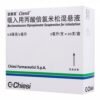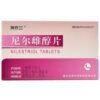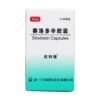Hormone-receptor-positive has two forms: ER and PR. ER+/PR+ means that cancer cells will develop and grow in response to different estrogens, indicating that breast cancer is hormone receptor-positive. The abbreviation is : ER/PR positive.
HER-2 (-) human epidermal growth factor receptor 2 (human epidermal growth factor receptor 2) is a protein encoded by the ERBB2 gene. When not expressed in breast cancer cells, the abbreviation is: HER2 negative
HR-positive/HER2-negative breast cancer is the most common type of breast cancer, accounting for approximately 70% of all new cases.
ER/PR (+) positive, HER2 (-) negative breast cancer tumors will respond to hormone therapy. Patients can use hormone therapy for maintenance treatment after surgery, chemotherapy and radiotherapy. These treatments can help prevent breast cancer from coming back by blocking the effects of estrogen.
medicine
1. Tamoxifen
Tamoxifen was originally synthesized by chemist Dora Richardson in 1962. Tamoxifen prevents cancer from coming back by blocking hormone receptors and preventing estrogen from binding to breast cancer cells. Tamoxifen is used to treat early and advanced estrogen receptor-positive (ER-positive or ER+) breast cancer in pre- and postmenopausal women. It is also the most common hormone treatment for male breast cancer.
Maintenance treatment with tamoxifen can sometimes take up to 5 years after completing initial treatment for breast cancer.
aromatase inhibitor
Aromatase is an enzyme that synthesizes estrogen. Aromatase inhibitors block the synthesis of estrogen, which lowers estrogen levels and slows cancer growth.
2. Anastrozole
The aromatase inhibitor anastrozole is used to prevent and treat breast cancer in women.
Anastrozole is the drug of choice for the treatment of postmenopausal estrogen receptor-positive women.
3. Exemestane
The aromatase inhibitor exemestane is used as an adjuvant treatment for postmenopausal estrogen receptor-positive early-stage breast cancer and is also used in the treatment of advanced breast cancer in postmenopausal women whose disease has worsened after tamoxifen treatment.
4. Letrozole
The aromatase inhibitor letrozole is approved for the treatment of postoperative hormone-responsive breast cancer and for the treatment of localized or metastatic breast cancer in postmenopausal women with hormone receptor-positive or unknown receptor status. In the BIG 1–98 study, letrozole reduced the rate of cancer recurrence but did not change survival compared with tamoxifen in postmenopausal women with hormone-responsive breast cancer.
Letrozole has been used by fertility doctors to induce ovulation since 2001 because it has fewer side effects than Clomifene Citrate.
5. Fulvestrant
Fulvestrant is a selective estrogen receptor degrader (SERD) indicated for the treatment of postmenopausal women with hormone receptor (HR)-positive metastatic breast cancer with combined disease progression, and in combination with palbociclib/palbociclib (palbociclib) for the treatment of HR(+)-positive, HER2(-)-negative female breast cancer with advanced disease progression after endocrine therapy.
6. Toremifene
Toremifene is a selective estrogen receptor modulator (SERM) used to treat postmenopausal women with advanced breast cancer.
Side effects of toremifene include endometrial hyperplasia and endometrial cancer, and hypercalcemia may occur in women with bone metastases.
7. Everolimus
Everolimus is an inhibitor of mTOR, a protein that helps cancer cells grow and divide. Everolimus blocks mTOR, preventing tumors from forming new blood vessels and thereby limiting their growth. In treating breast cancer, everolimus appears to help hormone therapy drugs work better.
Everolimus is used together with the aromatase inhibitor exemestane to treat women with hormone receptor-positive, HER2-negative breast cancer.
8. Chidamide
Chidamide (Aplasa) is a subtype-selective histone deacetylase (HDAC) oral inhibitor developed by China Microchip Biotechnology. In November 2019, it was approved in China to be used in combination with an aromatase inhibitor for the treatment of hormone receptor-positive, human epidermal growth factor receptor-2-negative, postmenopausal, locally advanced or metastatic breast cancer that has recurred or progressed after endocrine therapy. patient.
CDK4/6 inhibitors
Cyclin-dependent kinases 4 and 6 (CDK4/6) are key regulators of the cell cycle and play a role in the transition from G1 to S phase. key role. CDK4/6 are overactive in many cancers, leading to uncontrolled cell proliferation. It is currently believed that the role of CDK4/6 inhibitors is to selectively inhibit CDK4/6 and restore cell cycle control, thereby blocking tumor cell proliferation. It also stimulates the immune system to attack and kill cancer cells.
9. Palbociclib
Palbociclib, also translated as palbociclib, with the trade name Ibrance, is a selective CDK4/6 inhibitor developed by Pfizer of the United States for the treatment of HR-positive and HER2-negative breast cancer.
Palbociclib is the first CDK4/6 inhibitor approved for cancer treatment
10. Verzenio (abemaciclib)
Abemaciclib, also translated as bomacillin, trade name Verzenio, developed by Eli Lilly and Company, is a CDK4/6 selective inhibitor used to treat advanced or metastatic breast cancer.
In October 2015, it was designated as a breakthrough therapy for breast cancer by the U.S. Food and Drug Administration (FDA).
On September 28, 2017, it was approved by the FDA for the treatment of patients with hormone receptor (HR)-positive, human epidermal growth factor receptor 2 (HER2)-negative advanced or metastatic breast cancer in the United States.
11. Ai Ruikang (Dalciril isethionate tablets)
Dalpiciclib is an inhibitor of CDK4 and CDK6. CDK4/6 (cyclin-dependent kinases 4 and 6) are key factors in regulating the cell cycle and can trigger the cell cycle from the growth phase (G1 phase) to the DNA replication phase (S period) transformation. Dalsilide can reduce the phosphorylation level of retinoblastoma protein downstream of the CDK4 and CDK6 signaling pathways and induce cell G1 phase arrest, thereby inhibiting the proliferation of tumor cells.
12. Ribociclib
Ribociclib is also translated as ribociclin, ribociclib and other names, and the trade name is Kisqali. It was developed by Novartis and Astex Pharmaceuticals and was approved for combined use with aromatase inhibitors (such as letrozole) in 2017. HR-positive, HER2-negative advanced or metastatic breast cancer.
13. Piqray (alpelisib)
Alpelisib is an inhibitor for the treatment of HR+/HER2- postmenopausal PIK3CA mutated advanced breast cancer. Abnormal regulation of the PAM (PI3K-AKT-mTOR) signaling pathway is closely related to tumor occurrence and metastasis. Therefore, with the advent and application of mTOR inhibitors, PI3K inhibitors, and CDK4/6 inhibitors, the treatment of advanced breast cancer has entered the “endocrine+” era of inhibitors combined with endocrine therapy.
14. Orserdu (elacestrant)
RAD1901, a selective estrogen receptor degrader (SERD), can dose-dependently degrade estrogen receptor α (ERα/ESR1) and inhibit estradiol-dependent ER-directed gene transcription and tumor growth.
15. Trodelvy (sacituzumab govitecan) Trodelvy (sacituzumab govitecan) is a “first-in-class” antibody conjugate drug targeting Trop-2. Trop-2 is a cell surface antigen highly expressed in multiple tumor types, including more than 90% of breast and bladder cancers. Trodelvy’s design connects the topoisomerase inhibitor SN-38 to a monoclonal antibody through a hydrolyzable linker. This unique combination delivers potent activity to Trop-2-expressing cells and microenvironments.
16. Truqap (Capivasertib)
Capivasertib is an ATP-competitive pan-AKT kinase inhibitor that potently inhibits AKT1, AKT2 and AKT3 kinases. Activation of the AKT signaling pathway, including alterations in PIK3CA, AKT1, and PTEN, can occur in many patients with HR+/HER2- advanced breast cancer, but may also occur in patients without these genetic alterations. The AKT signaling pathway is related to the occurrence of resistance to endocrine therapy.
17. Jingzhuda (Entinostat) is a new, oral HDAC inhibitor that selectively inhibits class I HDACs, especially the representative HDAC subtypes 1, 2, and 3. Thereby regulating the hyperacetylation of histones and promoting the transcriptional activation of specific genes, ultimately inhibiting cell proliferation, accelerating terminal differentiation and/or inducing apoptosis.















Leave a reply